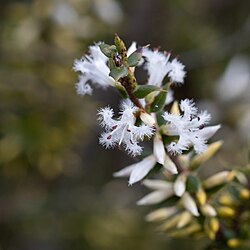Biology:Styphelia exarrhena
| Desert styphelia | |
|---|---|

| |
| In Cox Scrub Conservation Park | |
| Scientific classification | |
| Kingdom: | Plantae |
| Clade: | Tracheophytes |
| Clade: | Angiosperms |
| Clade: | Eudicots |
| Clade: | Asterids |
| Order: | Ericales |
| Family: | Ericaceae |
| Genus: | Styphelia |
| Species: | S. exarrhena
|
| Binomial name | |
| Styphelia exarrhena (F.Muell.) F.Muell.[1]
| |
| Synonyms[1] | |
| |
Styphelia exarrhena, commonly known as desert styphelia,[2] is a species of flowering plant in the heath family Ericaceae and is endemic to southern continental Australia. It is an erect shrub with erect or spreading egg-shaped leaves, and cream-coloured, tube-shaped flowers arranged singly or in pairs in upper leaf axils.
Description
Styphelia exarrhena is an erect shrub that typically grows to a height of 30–60 cm (12–24 in) and has downy branchlets. Its leaves are erect or spreading, egg-shaped, 3.2–9 mm (0.13–0.35 in) long and 1.4–4.5 mm (0.055–0.177 in) wide. The leaves are usually glabrous and have a small point on the tip. The flowers are arranged singly or in pairs in upper leaf axils and have egg-shaped bracts 0.7–1.2 mm (0.028–0.047 in) long and bracteoles 1.3–2 mm (0.051–0.079 in) long. The sepals are egg-shaped, 2.4–3.2 mm (0.094–0.126 in) long, the petal tube cream-coloured, 3.0–4.3 mm (0.12–0.17 in) long with lobes 3.2–5 mm (0.13–0.20 in) long and bearded. Flowering occurs from April to August and the fruit is a narrowly elliptic drupe about 2.5 mm (0.098 in) long.[2][3]
Taxonomy
This species was first formally described in 1859 by Ferdinand von Mueller, who gave it the name Leucopogon exarrhena in his Fragmenta Phytographiae Australiae.[4][5] In 1867, von Mueller transferred the species to Styphelia as S. exarrhena in a later edition of the Fragmenta, and that name is accepted by Plants of the World Online.[1] Styphelia exarrhena and S. adscendens are characterised by their stamens protruding from the petal tube.[6]
Distribution and habitat
Desert styphelia grows in mallee scrub, coastal shrublands and heath in sandy soil in the south-east of South Australia including on the Eyre Peninsula and Kangaroo Island, and in the Big Desert area of Victoria.[2][3]
Conservation status
Styphelia exarrhena is listed as "endangered" under the Victorian Government Flora and Fauna Guarantee Act.[2][7]
References
- ↑ 1.0 1.1 1.2 "Styphelia exarrhena". Plants of the World Online. https://powo.science.kew.org/taxon/urn:lsid:ipni.org:names:325762-1#synonyms.
- ↑ 2.0 2.1 2.2 2.3 Albrecht, David E.; stajsic, Val. "Styphelia exarrhena". Royal Botanic Gardens Victoria. https://vicflora.rbg.vic.gov.au/flora/taxon/4af5c95f-569c-4d82-b0b1-8fdb66e66c27.
- ↑ 3.0 3.1 "Styphelia exarrhena". State Herbarium of South Australia. http://www.flora.sa.gov.au/cgi-bin/speciesfacts_display.cgi?form=speciesfacts&name=Styphelia_exarrhena.
- ↑ "Leucopogon exarrhena". APNI. https://id.biodiversity.org.au/instance/apni/525612. Retrieved 24 December 2023.
- ↑ von Mueller, Ferdinand (1859). Fragmenta phytographiae Australiae. Melbourne: Victorian Government Printer. p. 178. https://www.biodiversitylibrary.org/item/7218#page/185/mode/1up. Retrieved 24 December 2023.
- ↑ Lang, Peter. "Taming the heaths: re-definition of Styphelia and Leucopogon and the demise of Astroloma". State Herbarium of South Australia. https://know.ourplants.org/news/taming-the-heaths-re-definition-of-styphelia-and-leucopogon-and-the-demise-of-astroloma/.
- ↑ "Flora and Fauna Guarantee Act 1988 Threatened List". Victorian State Government. https://www.environment.vic.gov.au/__data/assets/pdf_file/0021/655410/FFG-Threatened-List-June-2023.pdf.
Wikidata ☰ Q17243688 entry
 |

